
Apamea sordens, the rustic shoulder-knot or bordered apamea, is a moth of the family Noctuidae. The species was first described by Johann Siegfried Hufnagel in 1766. It is distributed throughout Europe, east across the Palearctic to Central Asia and to China and Japan. It also occurs in North America.

The red-tailed chipmunk is a species of rodent in the family Sciuridae. It is found in Alberta and British Columbia in Canada and Montana, Idaho and Washington in the United States.

Caradrina morpheus, the mottled rustic, is a moth of the superfamily Noctuoidea. The species was first described by Johann Siegfried Hufnagel in 1766. It is found across the Palearctic from northern Europe to Siberia, Amur and Korea. Also in Armenia and Turkestan. It was accidentally introduced on both the east and west coasts of Canada and is so far reported in the east from New Brunswick to Ontario, and in the west from British Columbia.

Hypenodes is a genus of moths of the family Erebidae erected by Henry Doubleday in 1850.

Eumacaria is a monotypic moth genus in the family Geometridae described by Packard in 1873. Its only species, Eumacaria madopata, the brown-bordered geometer moth, was first described by Achille Guenée in 1857. It is found in North America, where it has been recorded from British Columbia, northern Washington, southern Saskatchewan, from Maine to Florida, South Dakota, North Dakota, Nebraska, Wyoming, Idaho, Colorado and New Mexico. The habitat consists of orchards and shrublands. The species is listed as threatened in Connecticut.

Autographa sansoni, the Alberta beauty, is a moth of the family Noctuidae. The species was first described by F. H. Wolley Dod in 1910. It is found in the western mountains of North America, from Alaska south to Oregon, Idaho and Arizona. Occurring mainly in the Pacific Northwest, it thrives in mid-to-high elevation conifer forest habitat, as well as some areas of coastal rain forest in the Coast range. However, it is also found in a non-contiguous range in sub-alpine forest in the Rocky Mountains, ranging from Alberta in the north, to New Mexico in the south. The wingspan of an adult ranges between 34 and 36 mm. It is widespread, and a relatively common species.
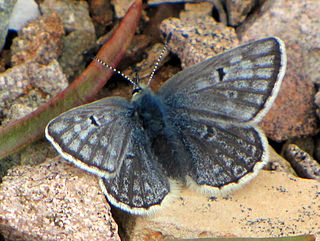
Agriades glandon, the Arctic blue or Glandon blue, is a species of butterfly in the family Lycaenidae. It in found in Eurasia and North America.
Hypocoena basistriga is a species of moth of the family Noctuidae first described by James Halliday McDunnough in 1933. It is found from Newfoundland and Labrador west to British Columbia and Yukon. This species of moth is found to frequent mesic areas including the edges of aspen bluffs and hayfields, old fields, meadows, etc.
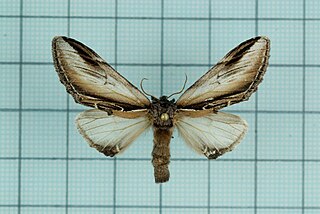
Pheosia rimosa, the black-rimmed prominent moth, fissured prominent or false-sphinx, is a moth of the family Notodontidae. The species was first described by Alpheus Spring Packard in 1864. It is found from coast to coast in North America, although it is less common in the south-eastern United States.
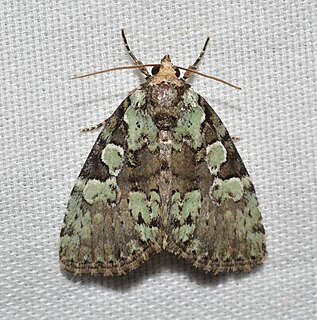
Leuconycta lepidula, the marbled-green leuconycta moth, marbled-green jaspidia or dark leuconycta, is a moth of the family Noctuidae. The species was first described by Augustus Radcliffe Grote in 1874. It is found in North America from Nova Scotia to North Carolina, west to Texas and north to Alberta.
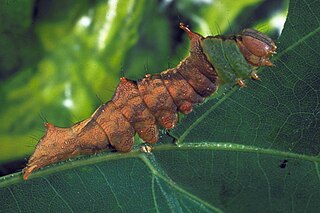
Schizura unicornis, the unicorn caterpillar moth, unicorn prominent or variegated prominent, is a moth of the family Notodontidae. The species was first described by James Edward Smith in 1797. It is found in all of North America, except the arctic north.
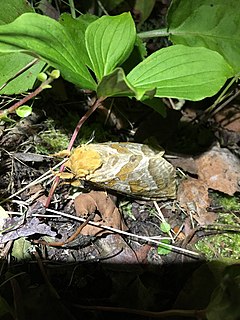
Sthenopis purpurascens, the four-spotted ghost moth, is a species of moth of the family Hepialidae. It was described by Packard in 1863. It is found in Canada and the United States, from Labrador and New York north and west to British Columbia and the Northwest Territories, south in the mountains to Arizona.

Hypenodes humidalis, the marsh oblique-barred, is a moth in the family Erebidae. The species was first described by Henry Doubleday in 1850. It is found in most of Europe and across the Palearctic to Siberia.
Hypenodes fractilinea, the broken-line hypenodes, is a moth in the family Erebidae. The species was described by John B. Smith in 1908. It is found from Nova Scotia south to North Carolina, west across Canada to Alberta. The habitat consists of mixed wood and deciduous woodland.
Hypenodes franclemonti is a species of moth in the family Erebidae. It was described by Douglas C. Ferguson in 1954. It is found in North America, including Florida, Michigan, Minnesota, Missouri, Pennsylvania and Quebec.
Hypenodes palustris is a species of moth in the family Erebidae. It was described by Douglas C. Ferguson in 1954. It is found in North America, including Alaska, Maryland, Minnesota, New Brunswick, Nova Scotia, Ontario, Quebec and Wisconsin.
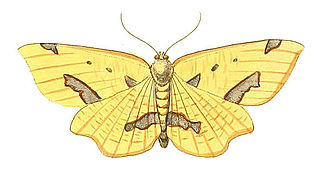
Xanthotype sospeta, the crocus geometer, is a species of moth in the family Geometridae. It was first described by Dru Drury in 1773 from Jamaica. It is also found in North America, where it has been recorded from Nova Scotia to southern British Columbia, south to Colorado and Georgia. The habitat consists of deciduous and mixedwood forests.

Orthosia hibisci, the speckled green fruitworm moth, is a moth of the family Noctuidae. It is found in most of North America, except in desert regions. The habitat consists of moist forests, riparian, agricultural and urban areas.
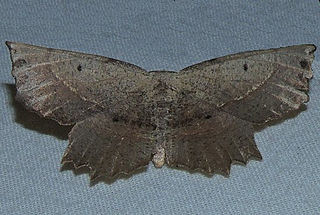
Euchlaena obtusaria, the obtuse euchlaena moth, is a moth of the family Geometridae. The species was first described by Jacob Hübner in 1813. It is found in North America, where it has been recorded from Alberta east to Nova Scotia, south to Florida and Texas. The habitat consists of mixed wood forests.

Euchlaena marginaria, the ochre euchlaena moth, is a moth of the family Geometridae. The species was first described by Charles Sedgwick Minot in 1869. It is found in North America, where it has been recorded from south-central British Columbia and Idaho to Nova Scotia and south to Florida and Missouri. The habitat consists of mixed wood and deciduous forests.














